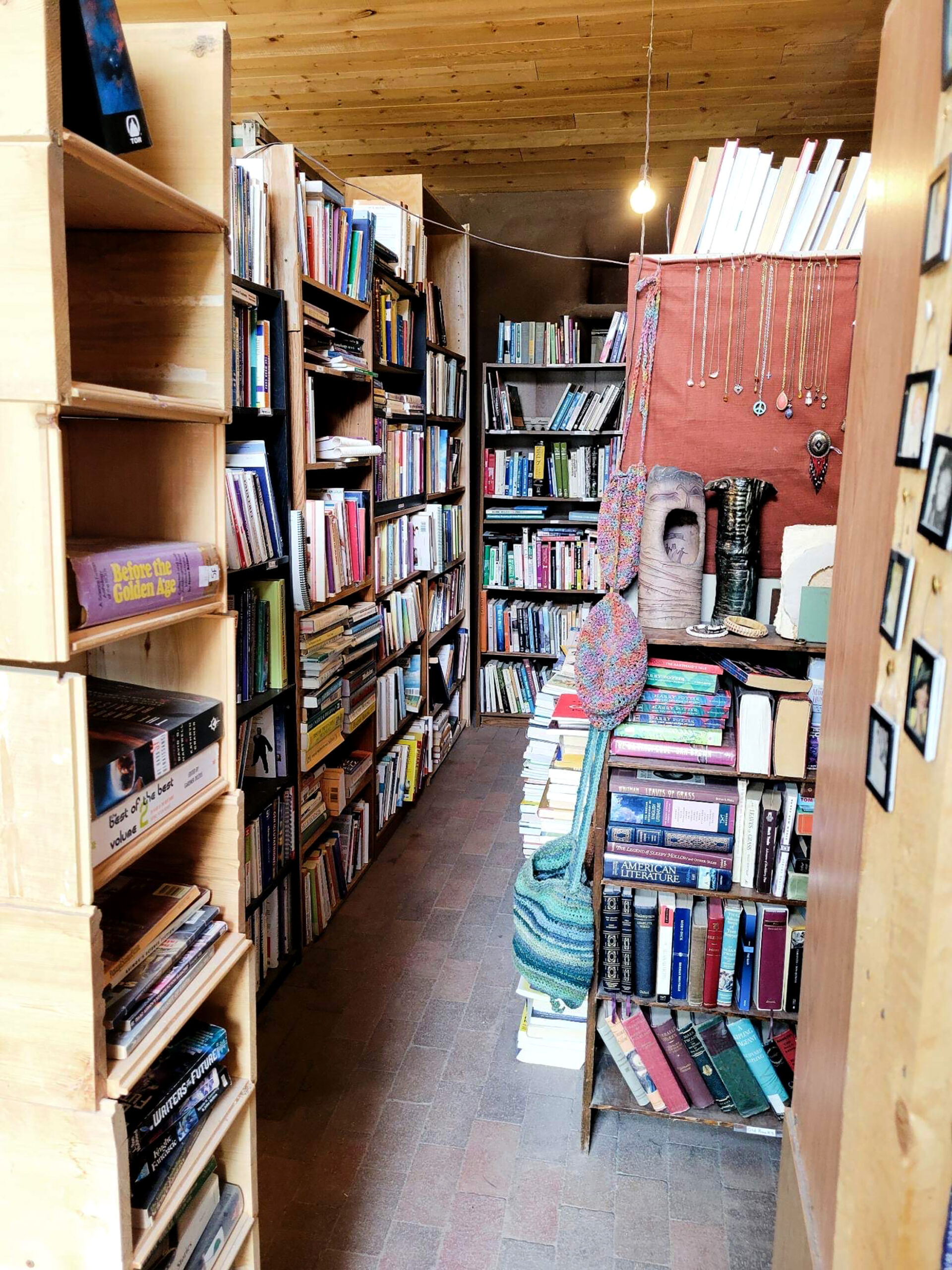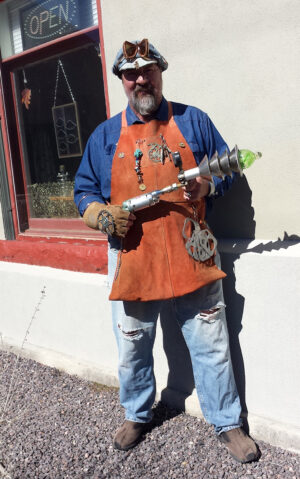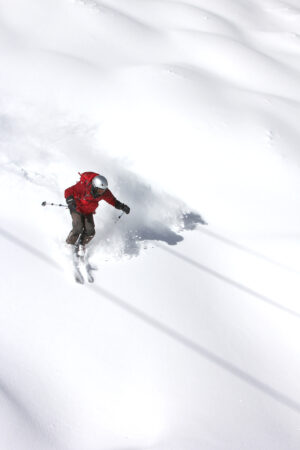MAGIC? AT A USED BOOKSTORE? You’d expect to find it at the tarot reader’s place, the Buddhist temples, or among the breathtaking 14,000-foot peaks towering over the small community of Crestone. But at the used bookstore? That’s right, if you intend to explore the esoteric wonders of the little town nestled among the Sangre de Cristos, don’t miss the Ragpicker Bookstore.

A visit to the Ragpicker, usually called “Carmin’s” by the locals, is an adventure. The shop is not hard to find; although, it is hidden among juniper and piñon trees. The Ragpicker sign on Golden Avenue varies from year to year because the extreme climate makes regular replacement necessary. An itinerant sign painter has used playful lettering in trade for tea, friendship and, of course, books. At the end of the road, a banner with 2-foot-high red letters announcing BOOKS flutters in the wind. The bookstore resides in the adobe house at 213 Golden Ave.
Carmin Teeple, 82, the proprietress of Ragpicker Books, specializes in pragmatic sustainability and creativity. You’ll notice a path toward the mountains lined with playful rusted tin can sculptures. Her land was once a dumping ground used by last century’s miners, and she’s recycled their ancient tin can remnants.
On the way to the house, you’ll encounter a little shed where people leave boxes of books that Carmin adds to her inventory or gives away to the town’s famous Free Box. Beyond the shed is the carport, which houses fiction and the children’s collection. Books here are sold by donation, and you can help yourself. Continue up the brick walkway past the fenced front garden and walk through an open gate constructed of artistic old mattress springs to a courtyard. There you’ll find shelves of $2 books; older or extra copies find their way here.
Ring the big cylindrical cast iron bell beside the door. Carmin will soon arrive to let you into one of the most fascinating collections of used books you’ve ever encountered.
The bookshop is open to the public year-round. You don’t need to wait for the summer tourist season. Make it a stop during the local Winterfest holiday shopping event or on a sojourn to the hot springs in the area. Shop hours can vary if the crochet group is meeting or it’s time for a community luncheon or coffeehouse jazz concert. A handwritten note on the front door will let you know when the lady is in, and she usually is. You can call the shop at 719-256-4511.
Carmin has lived in Crestone for about 20 years. Before she established the bookstore, she owned a thrift shop downtown. The bookstore’s first home was in the Sangre de Cristo Inn in 2005. But it soon outgrew the small retail space, and she decided to move it into her house. Be practical! Why pay rent?
Carmin appreciates the simple life, so go prepared with cash or check to purchase your treasures because there’s no card reader at the shop. You’ll receive a handwritten receipt. And if you bring books to her that she feels are resaleable, she’ll issue a neatly printed voucher toward a trade.
Like many used bookstores that rely on donations from the community, the inventory naturally reflects the interests of the denizens. And Crestone, by every stretch of the imagination, is a unique community. Because of the number of spiritual groups, Carmin has entire walls of shelves dedicated to Eastern and esoteric religions. Books on alien encounters snuggle up next to shamanism and yoga. Psychic, channeling and metaphysical manuals line the south wall. Histories of the area, Native American culture, and arts and crafts also reside in the first room, along with a good collection of local authors. You’re welcome to read on the futon couch (if the itinerant sign painter isn’t sleeping on it) upholstered with cushions and pillows Carmin has sewn.
You’ll also find an excellent collection of books on alternative architecture, which reflect Carmin’s interest in building. She stocks some new architectural books since so many people come to Crestone to learn or build sustainably. You don’t have to be a reader to learn about alternative building, though. The place is a model of sustainability. Carmin purposely left small areas unplastered to show off some of the techniques she used in building the house and shop she designed: Strawbale, cob, wattle and daub, and cordwood construction were all employed. Authentic adobe interior walls sport bas-relief designs (look for the dancing goddess). Southern windows provide passive solar heat; the brick floor provides the heat sink. Laid directly on the earth, the bricks were salvaged. Wood stoves warm both the shop and house in winter. The home has been featured on the annual Crestone Energy Fair’s tours for several years. Carmin will be happy to discuss her processes with you.
Moving on through the shop, you may not even notice the books on tantra and sacred sexuality, which occupy, amusingly, an “adults only” adobe niche next to books on gardening and seeds. Pass through a jewelry-adorned door to find poetry, psychology, philosophy, health and wellness, herbals and alternative medicine. There may be some classic sci-fi that didn’t make it to the carport. You never know what you’ll find. Looking for that scarce book by Ouspensky? Further down the stacks, you’ll encounter an area of self-help and nonfiction books organized by author after famous author.
Did I mention magic? Let me tell you a story. I visited during a snowy, gray weekend. It was so quiet; there were only two customers the whole day.
The first customer was, coincidentally, a freelance writer. As we talked shop in the philosophy/psychology room, he suddenly reached over my shoulder to grab a book. “Is that The Red Book?” he exclaimed. No. It was another book by Swiss psychiatrist Carl Gustav Jung. The writer explained that Jung’s The Red Book, published posthumously with the title Libre Novus, was rare. It’s an account of his “confrontation with the unconscious” in the first decades of the 20th century and contains the raw material from which Jung refined his theories and concepts. Jung coined the term synchronicity: “circumstances that appear meaningfully related yet lack a causal connection.” A chill runs down your spine when these coincidences happen, and you feel like the universe has sent you a message.
Later that afternoon, as snowflakes drifted outside the big windows that frame the shop’s front door, the other, final customer arrived. He was a young spiritual seeker working his way across the country toward California’s Mount Shasta by trading as he went. In his arms, he carried a huge crimson tome. The Red Book! He traded it for a white leather-bound Book of Enoch and went on his way.
Breathless, I had the opportunity to pour over the paintings and beautiful foreign lettering of The Red Book. Carmin took this “synchronicity of synchronicities” in stride, calmly looking up the price online and finding a place to display the giant book while I walked around in circles, stunned by the day’s magic. This was amazing! What did it mean? I wasn’t sure, but I knew I’d tell the story someday.
Expect magic to happen at Crestone’s Ragpicker Bookstore.
Winter Ross is a nomadic writer, artist (and sign painter) who lives in the San Luis Valley between Taos and Crestone when she’s not on the road. Follow her at: CeremonialVisions.com and WintersWeb.JournoPortfolio.com



